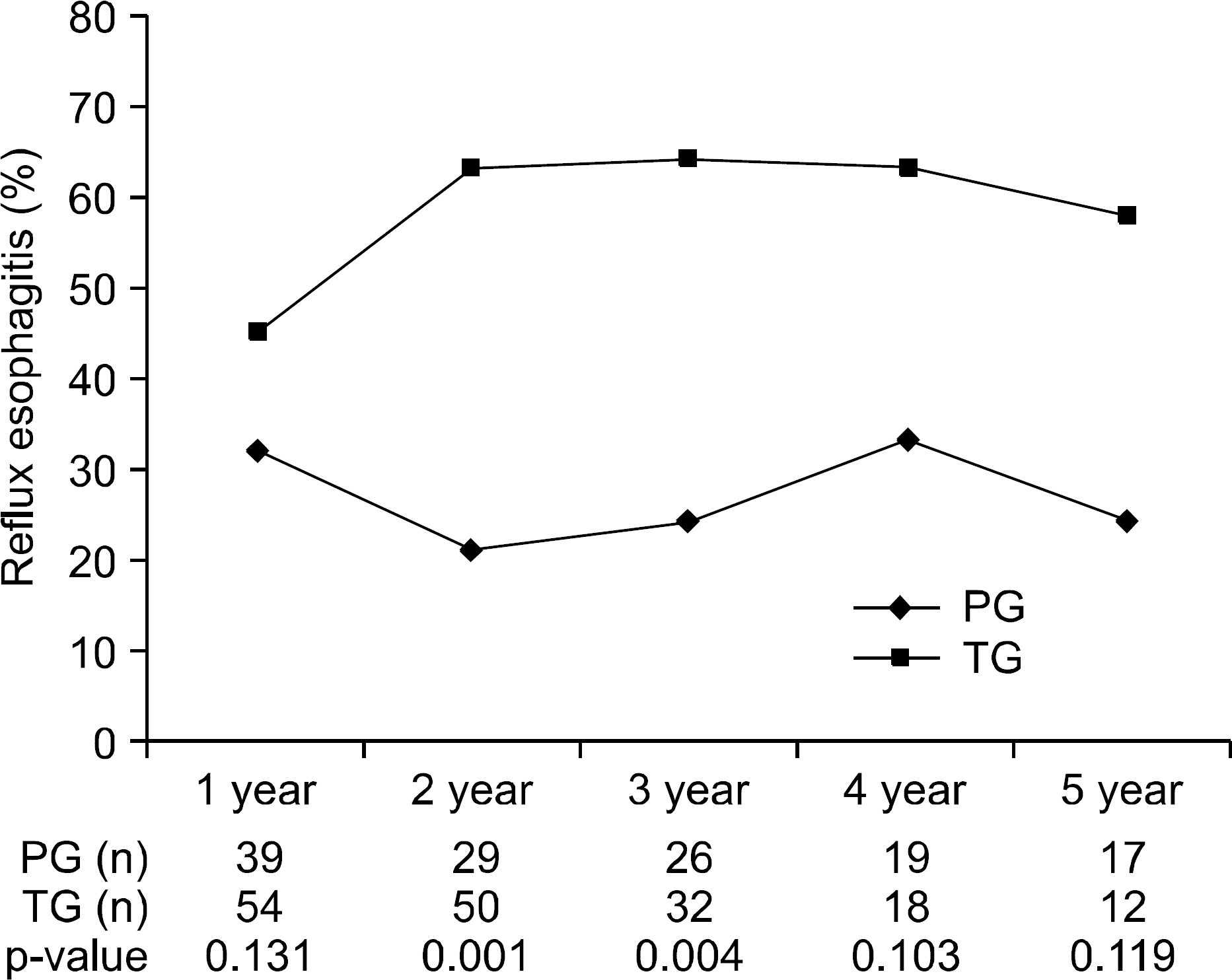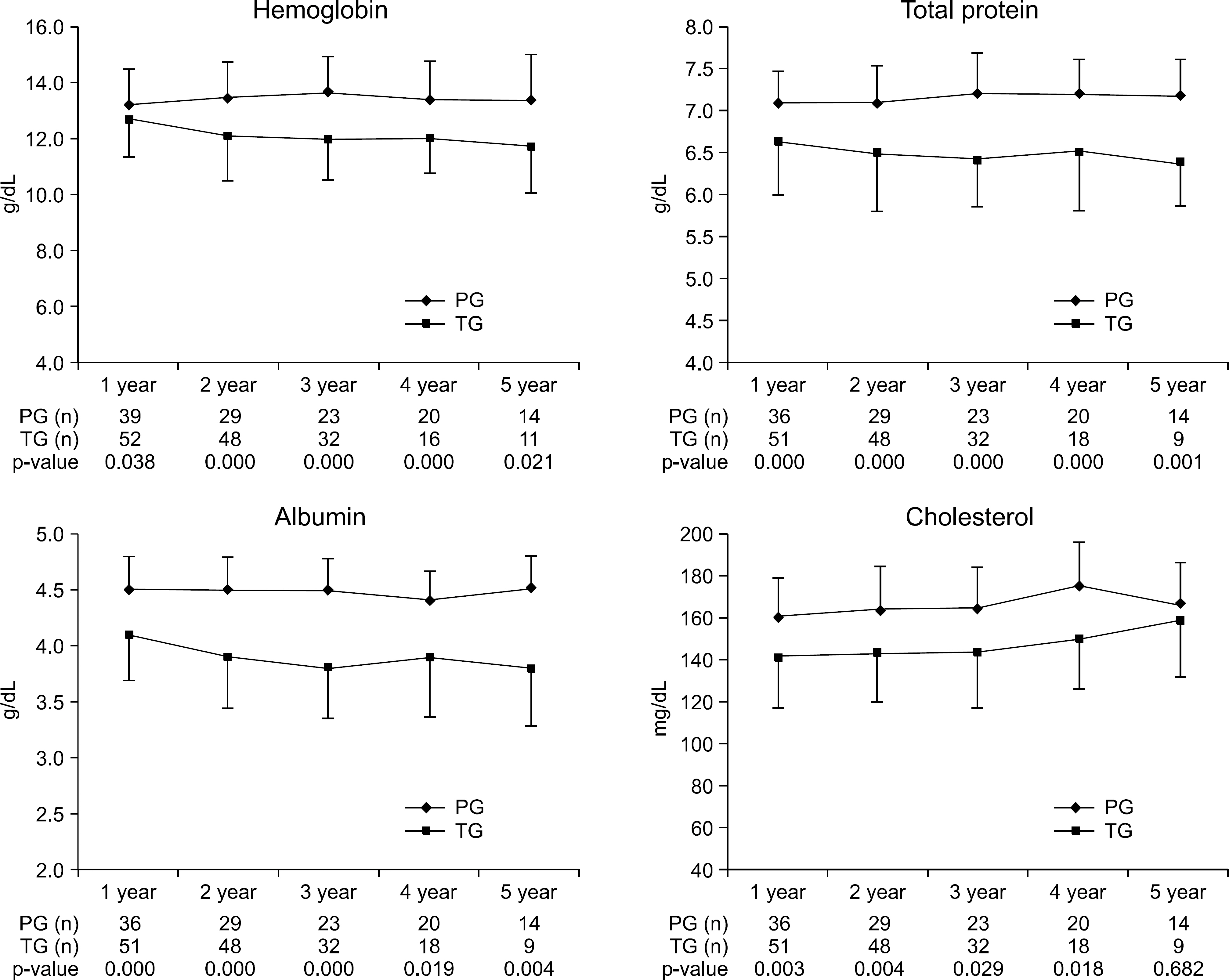Comparision between Proximal Gastrectomy and Total Gastrectomy in Early Gastric Cancer
- Affiliations
-
- 1Department of Internal Medicine, Chungnam National University College of Medicine, Daejeon, Korea. jeonghy@cnu.ac.kr
- 2Department of Surgery, Chungnam National University College of Medicine, Daejeon, Korea.
- 3Department of Pathology, Chungnam National University College of Medicine, Daejeon, Korea.
- 4Department of Diagnostic Radiology, Chungnam National University College of Medicine, Daejeon, Korea.
- KMID: 783226
- DOI: http://doi.org/10.4166/kjg.2009.54.4.212
Abstract
- BACKGROUND/AIMS
The purpose of this study was to evaluate clinical outcome of proximal and total gastrectomy regarding reflux esophagitis, nutritional state, and anemia in early gastric cancer.
METHODS
94 patients with early gastric cancer were included from January 2001 to January 2007 at Chungnam National University Hospital. Of whom 40 patients (31 men and 9 woman) had proximal gastrectomy (PG) and 54 patients (44 men and 10 woman) had total gastrectomy (TG). We reviewed all their medical and surgical record with surveying for gastrointestinal symptoms and reflux symptoms over the phone.
RESULTS
There were no significant differences between basic, surgical, and histopathologic characteristics. Bile reflux symptoms and heart burn symptoms were more common and severe in the TG group. The incidences of endoscopically detected reflux esophagitis were about 60% in the TG group and about 30% in the PG group. The hemoglobin levels were significantly higher in the PG group after the operation and were gradually decreased in the TG as the time went. The levels of laboratory variables such as total protein, albumin, and total cholesterol were lower in the TG group than in the PG group after the operation. However, stoma stricture after operation developed in the PG group more often than in the TG group, and esophageal balloon dilatations were performed more frequently in the PG group.
CONCLUSIONS
PG is favorable for proximal early gastric cancer in terms of reduced reflux esophagitis, anemia, and malnutrition except the stricture at esophagogastrostomy site.
Keyword
MeSH Terms
Figure
Cited by 3 articles
-
Consideration of Cardia Preserving Proximal Gastrectomy in Early Gastric Cancer of Upper Body for Prevention of Gastroesophageal Reflux Disease and Stenosis of Anastomosis Site
Jihoon Kim, Sungsoo Kim, Young-Don Min
J Gastric Cancer. 2012;12(3):187-193. doi: 10.5230/jgc.2012.12.3.187.Relationship of Body Weight, Anxiety Depression, and Quality of Life in Patients with Radical Gastrectomy according to Perioperative Period
In Kyoung Lee, Ja Yun Choi
Asian Oncol Nurs. 2014;14(4):212-220. doi: 10.5388/aon.2014.14.4.212.Laparoscopic Proximal Gastrectomy as a Surgical Treatment for Upper Third Early Gastric Cancer
Do Joong Park, Young Suk Park, Sang-Hoon Ahn, Hyung-Ho Kim
Korean J Gastroenterol. 2017;70(3):134-140. doi: 10.4166/kjg.2017.70.3.134.
Reference
-
1. Lee HJ, Yang HK, Ahn YO. Gastric cancer in Korea. Gastric Cancer. 2002; 5:177–182.
Article2. Hyung WJ, Kim SS, Choi WH, et al. Changes in treatment outcomes of gastric cancer surgery over 45 years at a single institution. Yonsei Med J. 2008; 49:409–415.
Article3. An JY, Youn HG, Choi MG, Noh JH, Sohn TS, Kim S. The difficult choice between total and proximal gastrectomy in proximal early gastric cancer. Am J Surg. 2008; 196:587–591.
Article4. Noh SM, Jeong HY, Lee BS, et al. Pylorus-preserving proximal gastrectomy vs.total gastrectomy with jejunal interposition for proximal gastric adenocarcinomas. J Korean Gastric Cancer Assoc. 2002; 2:145–150.5. Lim HJ, Jeong YJ, Yang DH. A comparative study on the outcomes of total and proximal gastrectomies performed for gastric cancer. Korean J Gastroenterol. 2002; 40:364–370.6. Imada T, Rino Y, Takahashi M, et al. Postoperative functional evaluation of pylorus-preserving gastrectomy for early gastric cancer compared with conventional distal gastrectomy. Surgery. 1998; 123:165–170.
Article7. Park DJ, Lee HJ, Jung HC, Kim WH, Lee KU, Yang HK. Clinical outcome of pylorus-preserving gastrectomy in gastric cancer in comparison with conventional distal gastrectomy with Billroth I anastomosis. World J Surg. 2008; 32:1029–1036.
Article8. Yun SP, Kim DH, Kim DH. Clinical analysis of jujunal pouch reconstruction after total gastrectomy for gastric cancer. J Korean Surg Soc. 2007; 72:203–209.9. Yumiba T, Kawahara H, Nishikawa K, Inoue Y, Ito T, Matsuda H. Impact of esophageal bile exposure on the genesis of reflux esophagitis in the absence of gastric acid after total gastrectomy. Am J Gastroenterol. 2002; 97:1647–1652.
Article10. Bae JM, Park JW, Kim JP. Nutritional assessment and intestinal absorption studies on total gastrectomized gastric cancer patients. J Korean Surg Soc. 1996; 50:475–487.11. Cho SJ, Jegal YJ. Nutritional status, and mucosal morphology of jejunum after total gastrectomy for carcinoma of the stomach. J Korean Surg Soc. 1990; 39:726–734.12. Chanarin I. The megaloblastic anemia. 1st ed.Oxford: Blackwell Scientific;1969.13. Chae HD, Park KH. Vitamin B12 deficiency after a total gastrectomy in patients with gastric cancer. J Korean Gastric Cancer Assoc. 2006; 6:6–10.
Article14. Yu WS, Chung HY. Nutritional status after curative surgery in patients with gastric cancer: comparision of total versus subtotal gastrectomy. J Korean Surg Soc. 2001; 60:297–301.
- Full Text Links
- Actions
-
Cited
- CITED
-
- Close
- Share
- Similar articles
-
- Single-Port Laparoscopic Proximal Gastrectomy with Double Tract Reconstruction for Early Gastric Cancer: Report of a Case
- Laparoscopic Proximal Gastrectomy as a Surgical Treatment for Upper Third Early Gastric Cancer
- Intracorporeal Anastomosis in Laparoscopic Gastric Cancer Surgery
- Function-Preserving Surgery in Gastric Cancer
- Non-Randomized Confirmatory Trial of Laparoscopy-Assisted Total Gastrectomy and Proximal Gastrectomy with Nodal Dissection for Clinical Stage I Gastric Cancer: Japan Clinical Oncology Group Study JCOG1401



